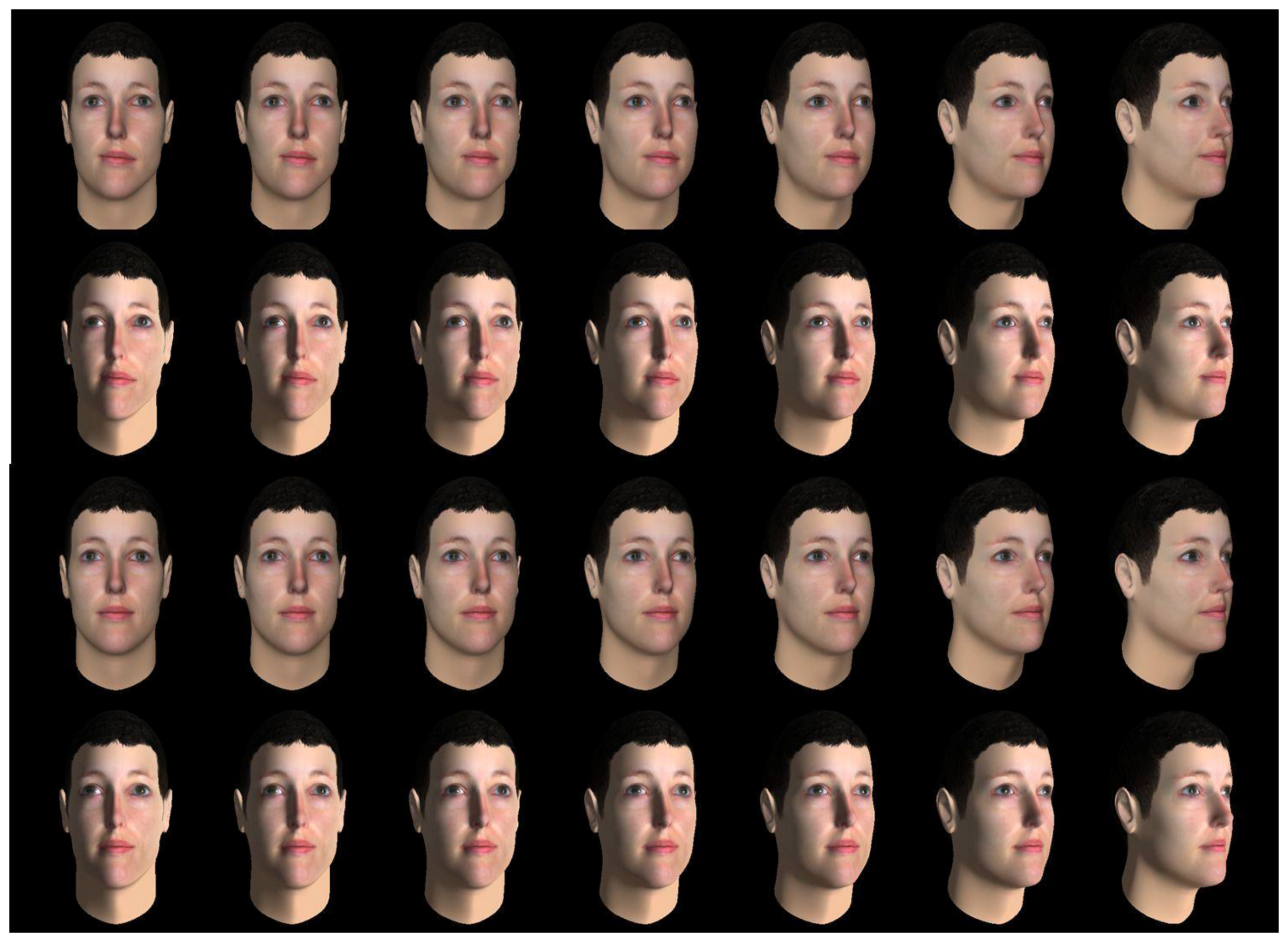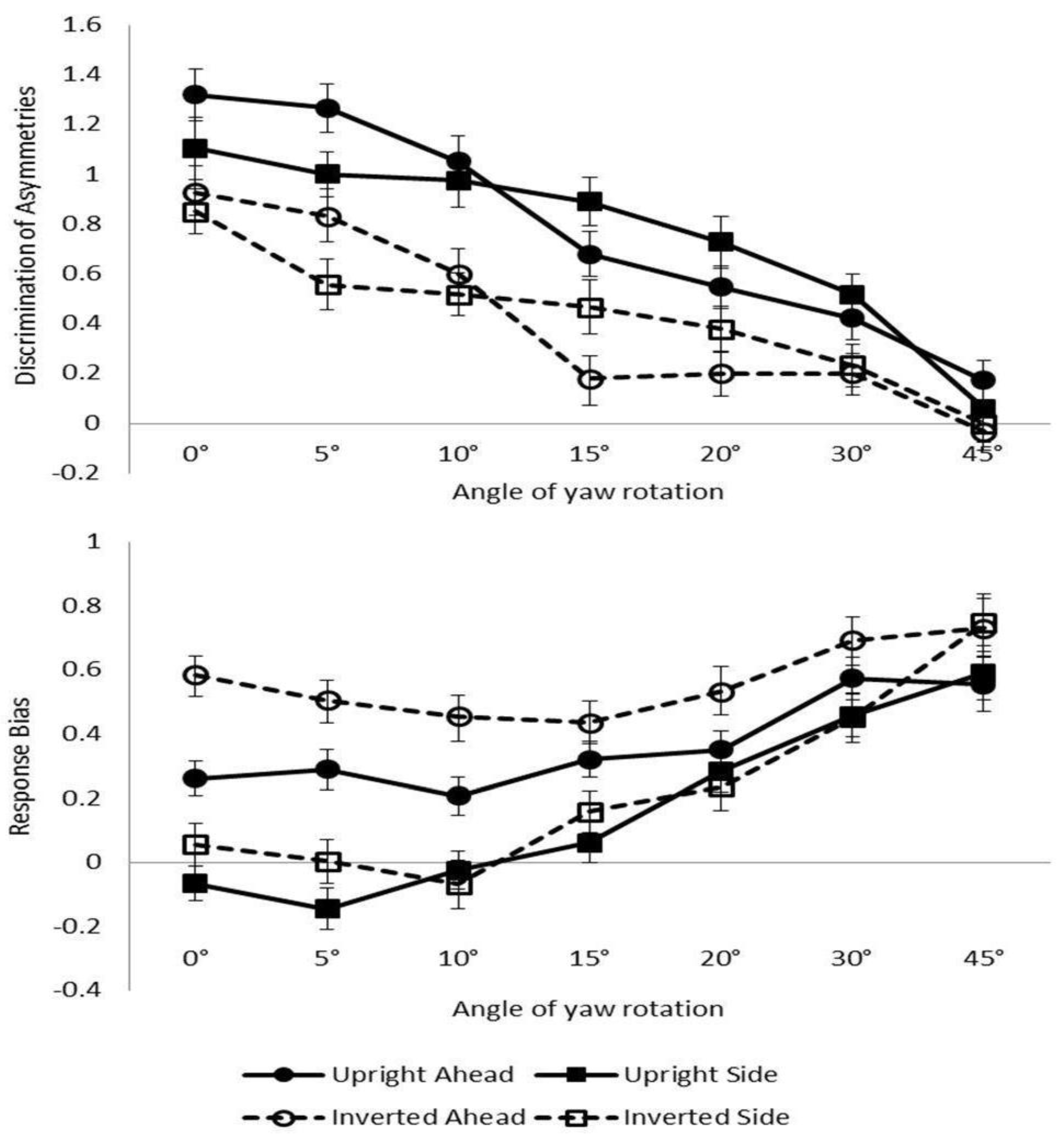Factors Affecting the Perception of 3D Facial Symmetry from 2D Projections
Abstract
:1. Introduction
1.1. Symmetry Detection Versus Symmetry Preference
1.2. Inversion Effects on Symmetry
1.3. Three-Dimenional Symmetry in 2D Projections
2. Experiment 1
2.1. Method
2.1.1. Participants
2.1.2. Stimuli
2.1.3. Procedure
2.1.4. Design
2.2. Results
2.3. Discussion
3. Experiment 2
3.1. Method
3.1.1. Participants
3.1.2. Stimuli
3.1.3. Procedure
3.1.4. Design
3.2. Results
3.3. Discussion
4. Conclusions
Conflicts of Interest
References
- Babu, D.; Roy, S. Left–right asymmetry: Cilia stir up new surprises in the node. Open Biol. 2013, 3, 130052. [Google Scholar] [CrossRef] [PubMed]
- Levin, M. Left–right asymmetry in embryonic development: A comprehensive review. Mech. Dev. 2005, 122, 3–25. [Google Scholar] [CrossRef] [PubMed]
- Møller, A.P. Fluctuating asymmetry in male sexual ornaments may reliably reveal male quality. Anim. Behav. 1990, 40, 1185–1187. [Google Scholar] [CrossRef]
- Thornhill, R.; Møller, A.P. Developmental stability, disease and medicine. Biol. Rev. Camb. Philos. Soc. 1997, 72, 497–548. [Google Scholar] [CrossRef] [PubMed]
- Palmer, A.R.; Strobeck, C. Fluctuating asymmetry: Measurement, analysis, patterns. Annu. Rev. Ecol. Syst. 1986, 17, 391–421. [Google Scholar] [CrossRef]
- Gangestad, S.W.; Thornhill, R.; Yeo, R.A. Facial attractiveness, developmental stability, and fluctuating asymmetry. Ethol. Sociobiol. 1994, 15, 73–85. [Google Scholar] [CrossRef]
- Grammer, K.; Fink, B.; Møller, A.P.; Thornhill, R. Darwinian aesthetics: Sexual selection and the biology of beauty. Biol. Rev. 2003, 78, 385–407. [Google Scholar] [CrossRef] [PubMed]
- Rhodes, G. The evolutionary psychology of facial beauty. Annu. Rev. Psychol. 2006, 57, 199–226. [Google Scholar] [CrossRef] [PubMed]
- Rhodes, G.; Proffitt, F.; Grady, J.M.; Sumich, A. Facial symmetry and the perception of beauty. Psychon. Bull. Rev. 1998, 5, 659–669. [Google Scholar] [CrossRef]
- Perrett, D.I.; Burt, D.M.; Penton-Voak, I.S.; Lee, K.J.; Rowland, D.A.; Edwards, R. Symmetry and human facial attractiveness. Evol. Hum. Behav. 1999, 20, 295–307. [Google Scholar] [CrossRef]
- Enquist, M.; Arak, A. Symmetry, beauty and evolution. Nature 1994, 372, 169–172. [Google Scholar] [CrossRef] [PubMed]
- Little, A.C.; Jones, B.C. Evidence against perceptual bias views for symmetry preferences in human faces. Proc. R. Soc. Lond. B Biol. Sci. 2003, 270, 1759–1763. [Google Scholar] [CrossRef] [PubMed]
- Pound, N.; Lawson, D.W.; Toma, A.M.; Richmond, S.; Zhurov, A.I.; Penton-Voak, I.S. Facial fluctuating asymmetry is not associated with childhood ill-health in a large British cohort study. Proc. R. Soc. Lond. B Biol. Sci. 2014, 281, 20141639. [Google Scholar] [CrossRef] [PubMed]
- Rhodes, G.; Peters, M.; Lee, K.; Morrone, M.C.; Burr, D. Higher-level mechanisms detect facial symmetry. Proc. R. Soc. Lond. B Biol. Sci. 2005, 272, 1379–1384. [Google Scholar] [CrossRef] [PubMed]
- Little, A.C.; Jones, B.C.; Burt, D.M.; Perrett, D.I. Preferences for symmetry in faces change across the menstrual cycle. Biol. Psychol. 2007, 76, 209–216. [Google Scholar] [CrossRef] [PubMed]
- Quist, M.C.; Watkins, D.C.; Smith, F.G.; Little, A.C.; DeBruine, L.M.; Jones, B.C. Sociosexuality predicts women’s preferences for symmetry in men’s faces. Arch. Sexual Behav. 2012, 4, 1415–1421. [Google Scholar] [CrossRef] [PubMed]
- Little, A.C.; Jones, B.C. Attraction independent of detection suggests special mechanisms for symmetry preferences in human face perception. Proc. R. Soc. Lond. B Biol. Sci. 2006, 273, 3093–3099. [Google Scholar] [CrossRef] [PubMed]
- Oinonen, K.A.; Mazmanian, D. Facial symmetry detection ability changes across the menstrual cycle. Biol. Psychol. 2007, 75, 136–145. [Google Scholar] [CrossRef] [PubMed]
- Scott, I.M.; Clark, A.P.; Boothroyd, L.G.; Penton-Voak, I.S. Do men’s faces really signal heritable immunocompetence? Behav. Ecol. 2013, 24, 579–589. [Google Scholar] [CrossRef] [PubMed]
- Lewis, M.B. Fertility affects asymmetry detection not symmetry preference in assessments of 3D facial attractiveness. Cognition 2017, 166, 130–138. [Google Scholar] [CrossRef] [PubMed]
- Yin, R.K. Looking at upside-down faces. J. Exp. Psychol. 1969, 81, 141. [Google Scholar] [CrossRef]
- Valentine, T. Upside-down faces: A review of the effect of inversion upon face recognition. Br. J. Psychol. 1988, 79, 471–491. [Google Scholar] [CrossRef] [PubMed]
- Valentine, T.; Lewis, M.B.; Hills, P.J. Face-space: A unifying concept in face recognition research. Q. J. Exp. Psychol. 2016, 69, 1996–2019. [Google Scholar] [CrossRef] [PubMed] [Green Version]
- Valentine, T.; Bruce, V. The effect of race, inversion and encoding activity upon face recognition. Acta Psychol. 1986, 61, 259–273. [Google Scholar] [CrossRef]
- Taubert, J.; Apthorp, D.; Aagten-Murphy, D.; Alais, D. The role of holistic processing in face perception: Evidence from the face inversion effect. Vis. Res. 2011, 51, 1273–1278. [Google Scholar] [CrossRef] [PubMed]
- Kanwisher, N.; Tong, F.; Nakayama, K. The effect of face inversion on the human fusiform face area. Cognition 1998, 68, B1–B11. [Google Scholar] [CrossRef]
- Rensch, B. Versuche über menschliche “Auslöser-Merkmale” beider Geschlechter. Zeitschrift für Morphologie und Anthropologie 1963, 53, 139–164. [Google Scholar]
- Washburn, D.K.; Crowe, D.W. Symmetries of Culture: Theory and Practice of Plane Pattern Analysis; University of Washington Press: Seattle, WA, USA, 1988. [Google Scholar]
- Makin, A.D.; Wilton, M.M.; Pecchinenda, A.; Bertamini, M. Symmetry perception and affective responses: A combined EEG/EMG study. Neuropsychologia 2012, 50, 3250–3261. [Google Scholar] [CrossRef] [PubMed]
- Dresp-Langley, B. Affine Geometry, Visual Sensation, and Preference for Symmetry of Things in a Thing. Symmetry 2016, 8, 127. [Google Scholar] [CrossRef]
- Sasaki, Y.; Vanduffel, W.; Knutsen, T.; Tyler, C.; Tootell, R. Symmetry activates extrastriate visual cortex in human and nonhuman primates. Proc. Natl. Acad. Sci. USA 2005, 102, 3159–3163. [Google Scholar] [CrossRef] [PubMed]
- Wagemans, J.; Van Gool, L.; d’Ydewalle, G. Orientational effects and component processes in symmetry detection. Q. J. Exp. Psychol. 1992, 44, 475–508. [Google Scholar] [CrossRef]
- Wenderoth, P. The effects of dot pattern parameters and constraints on the relative salience of vertical bilateral symmetry. Vis. Res. 1996, 36, 2311–2320. [Google Scholar] [CrossRef]
- Wagemans, J. Characteristics and models of human symmetry detection. Trends Cogn. Sci. 1997, 1, 346–352. [Google Scholar] [CrossRef]
- Lewis, M.B. The Lady’s not for turning: Rotation of the Thatcher illusion. Perception 2001, 30, 769–774. [Google Scholar] [CrossRef] [PubMed]
- Lewis, M.B.; Glenister, T.E. A sideways look at configural encoding: Two different effects of face rotation. Perception 2003, 32, 7–14. [Google Scholar] [CrossRef] [PubMed]
- Little, A.C.; Apicella, C.L.; Marlowe, F.W. Preferences for symmetry in human faces in two cultures: Data from the UK and the Hadza, an isolated group of hunter-gatherers. Proc. R. Soc. Lond. B 2007, 274, 3113–3117. [Google Scholar] [CrossRef] [PubMed]
- Chen, C.C.; Kao, K.L.C.; Tyler, C.W. Face configuration processing in the human brain: The role of symmetry. Cerebral Cortex 2006, 17, 1423–1432. [Google Scholar] [CrossRef] [PubMed]
- Koning, A.; Wagemans, J. Detection of symmetry and repetition in one and two objects: Structures versus strategies. Exp. Psychol. 2009, 56, 5–17. [Google Scholar] [CrossRef] [PubMed]
- Sawada, T. Visual detection of symmetry of 3D shapes. J. Vis. 2010, 10, 4. [Google Scholar] [CrossRef] [PubMed]
- Chen, C.C.; Sio, L.T. 3D surface configuration modulates 2D symmetry detection. Vis. Res. 2015, 107, 86–93. [Google Scholar] [CrossRef] [PubMed]
- Saunders, J.A.; Knill, D.C. Perception of 3D surface orientation from skew symmetry. Vis. Res. 2001, 41, 3163–3183. [Google Scholar] [CrossRef]
- Sawada, T.; Li, Y.; Pizlo, Z. Detecting 3-D mirror symmetry in a 2-D camera image for 3-D shape recovery. Proc. IEEE 2014, 102, 1588–1606. [Google Scholar] [CrossRef]
- Farell, B. The perception of symmetry in depth: Effect of symmetry plane orientation. Symmetry 2015, 7, 336–353. [Google Scholar] [CrossRef]
- Scheib, J.E.; Gangestad, S.W.; Thornhill, R. Facial attractiveness, symmetry and cues of good genes. Proc. R. Soc. Lond. B Biol. Sci. 1999, 266, 1913–1917. [Google Scholar] [CrossRef] [PubMed]
- Farrera, A.; Villanueva, M.; Quinto-Sánchez, M.; González-José, R. The relationship between facial shape asymmetry and attractiveness in Mexican students. Am. J. Hum. Biol. 2015, 27, 387–396. [Google Scholar] [CrossRef] [PubMed]
- Kaipainen, A.E.; Sieber, K.R.; Nada, R.M.; Maal, T.J.; Katsaros, C.; Fudalej, P.S. Regional facial asymmetries and attractiveness of the face. Eur. J. Orthod. 2015, 38, 602–608. [Google Scholar] [CrossRef] [PubMed]
- Schmid, K.; Marx, D.; Samal, A. Computation of a face attractiveness index based on neoclassical canons, symmetry, and golden ratios. Pattern Recognit. 2008, 41, 2710–2717. [Google Scholar] [CrossRef]



© 2017 by the author. Licensee MDPI, Basel, Switzerland. This article is an open access article distributed under the terms and conditions of the Creative Commons Attribution (CC BY) license (http://creativecommons.org/licenses/by/4.0/).
Share and Cite
Lewis, M.B. Factors Affecting the Perception of 3D Facial Symmetry from 2D Projections. Symmetry 2017, 9, 243. https://doi.org/10.3390/sym9100243
Lewis MB. Factors Affecting the Perception of 3D Facial Symmetry from 2D Projections. Symmetry. 2017; 9(10):243. https://doi.org/10.3390/sym9100243
Chicago/Turabian StyleLewis, Michael B. 2017. "Factors Affecting the Perception of 3D Facial Symmetry from 2D Projections" Symmetry 9, no. 10: 243. https://doi.org/10.3390/sym9100243




